Deepwater
-
- Storm Warnings Raised over Readiness Concerns Maritime Reporter, Jun 2004 #70
This June's two-year anniversary of the Coast Guard's award of contract for the Integrated Deepwater System reflects steady progress in efforts to modernize the nation's maritime guardians, but heightened concerns over falling readiness have led some congressional lawmakers to renew calls to accelerate the comprehensive 20-plusyear recapitalization program.
Coast Guard Commandant Adm.
Thomas H. Collins described his concern over current readiness trends in early March during congressional testimony on the Bush administration's proposed fiscal year 2005 budget.
"Our greatest threat to mission performance continues to be that our aircraft, boats and cutters are aging, technologically obsolete, and require replacement and modernization," Collins told the House Coast Guard and Maritime Transportation Subcommittee on March 4. Two weeks later, during his "State of the Coast Guard" address at the National Press Club in Washington.
D.C.. Collins elaborated. "There are storm warnings along our projected track line," he told a capacity audience.
"There are clear warning signals that our ability to sustain our readiness into the future is increasingly at risk. We are experiencing system failures at a steadily increasing rate." Readiness Down, Costs Up Vice Adm. Thomas J. Barrett, vice commandant of the Coast Guard, echoed the commandant's concerns during his own testimony on the Deepwater Program before the same House subcommittee April 26. Noting that most Coast Guard cutters and aircraft will reach the end of their projected service lives by 2010, Barrett revealed that the service's annual safety review for fiscal year 2003 reflected a mishap rate for reported apparent in-flight engine power losses of 62.74 per 100,000 flight hours.
"This rate is unacceptable," Barrett said, "and far exceeds the FAA [Federal Aviation Administration] guidelines of no more than 1 mishap per 100.000 hours or the U.S. Navy Safety Center guidelines of no more than 10 mishaps per 100,000 hours." Barrett emphasized that the Deepwater Program was urgently needed to recapitalize the Coast Guard. "1 cannot overstate the importance of the Deepwater acquisition on the current and future capability of your Coast Guard and its ability to meet national priorities," he said. "The Deepwater Program represents a direct investment in the maritime safety and security of the nation.
However, declining fleet readiness and increasing costs of maintaining aging assets are jeopardizing our ability to adequately address maritime security threats." Of note, Barrett said that the Coast Guard experienced 676 unscheduled maintenance days for its cutters during the past year-a 41 percent increase over 2002 and the equivalent of losing more than three and one-half cutters to service.
"We have legacy cutters that are free of major equipment casualties less than 50 percent of the time," he stated.
"Maintenance costs are escalating far beyond budgeted support levels and, given the exponential growth, choices become more and more difficult each year." Saying that Coast Guard crews took great pride in stretching the functional life of ships and aircraft, Barrett questioned how much longer they would be able to do so. "We have been able to maintain minimum levels of readiness largely through the Herculean efforts, courage, and innovation of your Coast Guard personnel, however, only so much is possible with assets that are largely obsolete and whose machinery continues to fail," he said.
Restacked Priorities Early in 2004 the Coast Guard took steps to reprioritize the Deepwater Program's modernization planning-what Collins described as a "restacking of priorities"- to address its growing concern with deteriorating readiness and system failures on legacy air and surface platforms.
Integrated Coast Guard Systems (ICGS), the joint venture between Northrop Grumman and Lockheed Martin serving as Deepwater's systems integrator, was directed to take immediate action to re-engine the Coast Guard's HH-65 "Dolphin" helicopter fleet. The re-engining project will gain momentum during the months ahead following installation of the first upgraded, more powerful replacement engine and improved fuel-control system on an HH- 65 helicopter in May.
In response to continued deterioration in the hull condition of its fleet of 110- foot Island-class patrol boats (WPBs), the Coast Guard's senior leadership also ordered the acceleration of the design and development of Deepwater's Fast Response Cutter-the intended replacement for 110-foot boats-as well as moving forward on the design of the Offshore Patrol Cutter, the platform slated to replace the Coast Guard's medium endurance cutter fleet. A business-case analysis is being conducted to determine the appropriate number of 110-foot to 123-foot Deepwater conversions to complete prior to the transition to the FRC; a decision is expected later this year. Eight 110s are now under contract for conversion by Bollinger Shipyards into the upgraded 123-foot design; the first boat to be converted, the Matagorda, was delivered to the Coast Guard in March.
Deepwater's modernization upgrades for C4ISR (command, control, communications, computers, intelligence, sur- veillance, and reconnaissance) systems on legacy assets and at shore installations also have been adjusted to be responsive to emergent requirements. In response to a request from the Pacific Area Commander in March, for example, the Coast Guard accelerated Deepwater's planned C4ISR upgrades on the Cutters MUNRO and RUSH to support upcoming out-of-hemisphere deployments.
The upgrades provided each cutter with access to the Department of Defense's Secure Internet Protocol Routing Network (SIPRNET) and a classified local area network.
Concurrent with these command-andcontrol upgrades, Deepwater's C4ISR upgrade at the Communications Area Master Station Pacific (CAMSPAC) facility at Point Reyes, Calif., was completed.
The first shore-based communications upgrade under the Integrated Deepwater System was completed in September 2003 at Communications Area Master Station Atlantic (CAMSLANT).
"Looking ahead," Barrett told the Subcommittee, "it is clear that attaining additional capacity and capability is critical to the Coast Guard's ability to achieve the levels of future readiness needed to perform its expanded homeland- security tasks while concurrently carrying out its other responsibilities." RAND: "An Open Question" The RAND Corporation reinforced this view with its recent release of the findings of its independent, third-party evaluation of the Deepwater Program. In November 2002, the Coast Guard's Deepwater Program Office commissioned RAND to evaluate whether the Deepwater Program remains valid for the Coast Guard's new, traditional, and emerging responsibilities and missions as a result of the terrorist attacks of 9/11.
Faced with a legislative requirement to report to Congress on the feasibility of accelerating the Deepwater program, RAND also was asked by the Deepwater Program Office to complete its own evaluation of the feasibility of doing so.
Noting that the current Deepwater acquisition buildout was planned before the 9/ll terrorist attacks, RAND documented how the Coast Guard has taken on expanded roles in homeland defense and homeland security in the new Department of Homeland Security.
"Whether the original 20-year Deepwater acquisition schedule is appropriate for these new conditions is an open question," RAND concluded.
The RAND study, delivered in April, recommended that the Coast Guard pursue a two-pronged strategy to accelerate and expand Deepwater's current plan to acquire new assets-with twice as many cutters and 50 percent more air vehiclesand, at the same time, to identify and explore new platform options, emerging technologies, and operational concepts that could leverage those assets. The Coast Guard will use the results of the RAND study as an additional data point in its ongoing assessment of the need to revise Deepwater's requirements for recapitalizing the Coast Guard in light of the post-9/11 operating environment.
This assessment will be completed this summer and reviewed by the Department of Homeland Security's Joint Requirements Council. Program officials emphasize that Deepwater's acquisition strategy and current Deepwater Implementation Plan solution remain sound for the new and evolving responsibilities and missions that the Coast Guard has been asked to undertake.
The Deepwater system-of-system acquisition [Ed. Note: see "Special Report: Deepwater," Maritime Reporter, July 2003] retains the flexibility to enable it to be adapted to changing circumstances and emerging requirements, they say.
"There have been some people who have looked at the status of the Deepwater program at the present budget time and wondered why the 20-year marathon, as initially defined at contract award, has changed somewhat," said Rear Adm. Patrick M. Stillman, Deepwater's program executive officer, at the Navy League's Sea-Air-Space Exposition in Washington, D.C., in April. "The answer to that question is that change is fundamental our planetary existence, and it is absolutely fundamental to the agility and flexibility of this contracting strategy that will bring this enterprise to fruition Lawmakers Urge Acceleration Homeland-security minded lawmakers in both the U.S. House of Representatives and the U.S. Senate have sponsored efforts to increase Deepwater's funding level to enable it to be completed in 10 to 15 years. Last November, 14 senators signed a joint letter to the director of the Office of Management and Budget urging the Bush administration to include $1,892 billion in fiscal year 2005 funding to accelerate the Deepwater Program as a "prudent way" to improve U.S. homeland security. Of the $6.8 billion in fiscal year 2004 funding appropriated for the Coast Guard, $668.2 million is allocated to Deepwater. The administration's budget proposal for fiscal year 2005 identifies $678 million in funding for the Deepwater modernization and recapitalization program. Citing the important need to provide adequate funding to enable the Coast Guard to continue to fulfill its many missions, the House of Representatives Transportation and Infrastructure Committee voted unanimously in April to approve bipartisan legislation authorizing approximately $8 billion for the Coast Guard in fiscal year 2005, including $1.1 billion for Deepwater. "This bill will provide the Coast Guard the resources that it needs to perform the many important homeland security and traditional missions that we expect the Coast Guard to carry out every day," said Rep. Frank LoBiondo (R-NJ).
chairman of the Coast Guard and Maritime Transportation Subcommittee.
"The bill allocates $1.1 billion for the Deepwater Program, putting us on track to accelerate the program's completion date to 2016-five years earlier than originally planned. Acceleration is critically needed as the Coast Guard's aging fleet of vessels and aircraft are deteriorating at an alarming rate." Earlier this year, the Senate amended its fiscal year 2004 authorization legislation for the Coast Guard to include a fiscal year 2005 authorization. House Transportation and Infrastructure Committee members said they will work to include the House authorization spending level in the final Coast Guard package that is forged during a Senate-House authorization conference this year. Rep. Don Young (RAlaska), the House Transportation Committee chairman, said, "It is important that we continue to support the work of the Coast Guard and to provide adequate funding to insure that the Coast Guard can continue to fulfill the many missions we have given them." Following his Subcommittee's Deepwater hearing in April, Rep.
LoBiondo reiterated his call to accelerate the Deepwater Program. "The dura duration and magnitude of the Deepwater program require continued oversight and adjustment of the acquisition plan to meet the ever-changing conditions that the Coast Guard faces in its operational environment," he said.
"The Subcommittee understands the importance of this ongoing review; however, we are concerned with impacts on costs, complexity and procurement delays that may result as the program is 're-baselined'. These adjustments to planned assets have combined with multiple years of underfunding to result in the situation that we find ourselves in today. The Coast Guard has estimated that the Deepwater program is now running at two to seven years behind the original 20-year schedule. This is simply unacceptable. We should be accelerating not decelerating," LoBiondo said.
Capt. Gordon I. Peterson, U.S. Navy (Ret.) is a technical director with Anteon Corporation's Center for Security Strategies and Operations.
-
- Shale Oil Is it a Threat to Future Deepwater Development? Maritime Reporter, Sep 2013 #12
sector looks healthy and growth remains strong. But the sudden expansion of shale oil and tight oil production could disrupt the growth trajectory in the deepwater sector. Deepwater The underlying drivers for deepwater development point toward continued sector growth. Spot and futures crude pricing is at
-
- Advanced Subsea Marine Technology, Jan 2013 #32
At the Cutting Edge of Deepwater Studies for the O&G industry in Brazil For more than 35 years, Advanced Subsea (AS) has been deeply involved in marine technological innovation. Through steady research and partnerships with research institutes in France and Brazil, Advanced Subsea has been developing
-
- Positive Outlook for Global Subsea Development, Deepwater Strengthening Maritime Reporter, Apr 2002 #50
of several significant ExxonMobil contracts including Kizomba in Angola, Erha in Nigeria and Leased Production System (LPS). With the award of Shell's deepwater Bonga trees offshore Nigeria in early 2001, ABB will supply about 34 trees into the market or a 33 percent share of the 104 subsea trees booked
-
- Deepwater One Delivers $ 2 . 3B Proposal to USCG Maritime Reporter, Nov 2001 #44
Deepwater One Team last month delivered a $2.3-biIlion proposal to the U.S. Coast Guard (USCG) for the design and development of an Integrated Deepwater System (IDS) that will help the Coast Guard meet vital offshore operational requirements into the 21st century. The team is led by Boeing and include
-
- Deepwater Business Prospects Ripe Maritime Reporter, Nov 2000 #49
It appears that the long-held promise of deepwater offshore discovery and recovery is well-positioned to pay off, particularly in the face of $30+ barrels of oil. As technology has increasingly allowed oil companies and offshore drilling firms to more accurately find and evaluate potential drilling
-
- LCS and Deepwater Share Much Maritime Reporter, Mar 2003 #26
operational challenges while developing their future fleets. The Navy's Littoral Combat Ship (LCS) program and the Coast Guard's Integrated Deepwater System (IDS) project offer new opportunities for collaboration and innovation between the sea services. The Navy's role of assuring access in the
-
- Schlumberger Launches Deepwater Vessel Maritime Reporter, Jan 2000 #23
Schlumberger introduced DeepSTIM — an advanced stimulation vessel. Launched last month for operation in the Gulf of Mexico, the vessel measures 260 x 56 ft. with its large capacity providing reliability in unfavorable weather conditions — allowing it to remain at sea for extended periods. A fully encl
-
- Tideland Introduces New Buoy Design For Deepwater Applications Maritime Reporter, Oct 1986 #41
Tideland Signal Corporation of Houston, Texas, has introduced the new SAB-12 Sentinel Articulated Buoy. According to the manufacturer, the buoy has outstanding station- keeping capabilities and may be deployed where water depth makes placement of a fixed structure impractical. The SAB-12 consists
-
- Deepwater, Heavy-Duty Jackup Joins Blue Streak Marine Fleet Maritime Reporter, Jun 1986 #82
offshore rigs in waters up to 100 feet deep, and lifting loads from its deck of up to 60 tons, has joined the Blue Streak Marine fleet. The vessel's deepwater capability and heavy-lift capacity can save contractors hundreds of thousands of dollars per job over other methods, according to Dennis Good
-
- Literature Available On Sperry's New Deepwater Navigation System Maritime Reporter, Nov 1984 #14
Sperry Corporation has announced the development of a high accuracy, deepwater integrated navigation system for use aboard seismic exploration vessels, and is now offering this system to potential users of such equipment. Free literature is now available from Sperry completely describing the new
-
- Halter To Build Deepwater, ME 202s And ME 303s In The United States Maritime Reporter, Mar 1983 #40
drawing boards now. Two of the Maritime Engineering vessels that are available now from Halter are the ME 303 and ME 202. The ME 303 is a deepwater, anchor/handling, tug7 supply boat designed to handle the anchors of the new generation of semisubmersible drilling rigs. The 223-foot, 12,000-bhp
-
 )
April 2024 - Maritime Reporter and Engineering News page: 21
)
April 2024 - Maritime Reporter and Engineering News page: 21and the turret business, then dif? cult to provide quantitative ? gures as this is driven by the moving to New Orleans to work on Gulf of Mexico deepwater developers and approval regime,” said Langford. “However, projects with Shell. Eventually he settled in Houston, working we are gung ho about
-
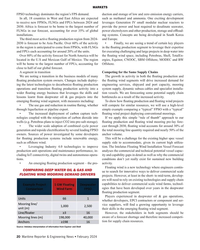 )
February 2024 - Maritime Reporter and Engineering News page: 20
)
February 2024 - Maritime Reporter and Engineering News page: 20? oating energy business that leverages the skills and tion vessels. We are forecasting some potential supply chain lessons learnt from deepwater oil & gas projects into the bottlenecks as a result of the increased activity. emerging ? oating wind segment, with measures including: To show
-
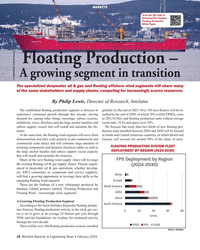 )
February 2024 - Maritime Reporter and Engineering News page: 18
)
February 2024 - Maritime Reporter and Engineering News page: 18the Intelatus Floating Production White Paper. Floating Production – A growing segment in transition © AdobeStock_Dolores Harvey The specialized deepwater oil & gas and ? oating offshore wind segments will share many of the same stakeholders and supply chains, competing for increasingly scarce resources
-
 )
September 2023 - Marine Technology Reporter page: 56
)
September 2023 - Marine Technology Reporter page: 56.com/ Birns (CA) https://birns.com/ DeepSea Power & Light (CA) https://www.deepsea.com/ Deep Trekker (ON) https://www.deeptrekker.com/ Deepwater Exploration (CA) https://dwe.ai/ Imenco (UK) https://imenco.no/technology/camera-lights J.W. Fishers (MA) www.jw? shers.com MacArtney/Luxus https://ww
-
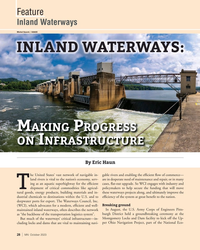 )
October 2023 - Marine News page: 28
)
October 2023 - Marine News page: 28along, and ultimately improve the dustrial chemicals to destinations within the U.S. and to ef? ciency of the system at great bene? t to the nation. deepwater ports for export. The Waterways Council, Inc. Breaking ground (WCI), which advocates for a modern, ef? cient and well- In August, the U.S. Army
-
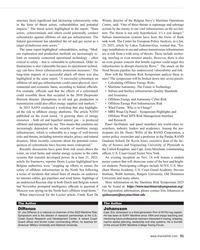 )
September 2023 - Maritime Reporter and Engineering News page: 51
)
September 2023 - Maritime Reporter and Engineering News page: 51of? cials said that the effects of a cyberattack • Subsea and Surface infrastructure Quality Standards could resemble those that occurred in the 2010 Deepwater and Assurance Horizon disaster. Disruptions to oil and gas production or • Offshore Energy and Autonomy Cyber Risk transmission could also affect
-
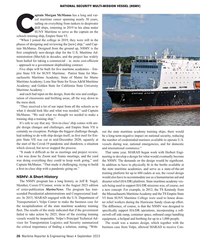 )
September 2023 - Maritime Reporter and Engineering News page: 26
)
September 2023 - Maritime Reporter and Engineering News page: 26VESSEL (NSMV) aptain Morgan McManus has a long and var- ied maritime career spanning nearly 30 years, sailing on everything from tankers to deepwater drill ships, returning in 2019 to his alma mater CSUNY Maritime to serve as the captain on the schools training ship, Empire State VI. “When I
-
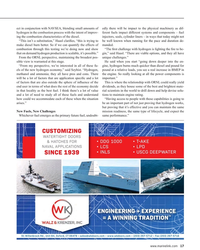 )
September 2023 - Maritime Reporter and Engineering News page: 17
)
September 2023 - Maritime Reporter and Engineering News page: 17future fuel, undoubt- same performance.” CUSTOMIZING WATERTIGHT DOORS & HATCHES FOR • DDG 1000 • T-AKE NAVAL APPLICATIONS • LCS • LPD • INLS • USCG DEEPWATER SINCE 1939 ENGINEERING + EXPERIENCE ™ = A WINNING TRADITION 91 Willenbrock Rd., Unit B4, Oxford, CT 06478 • [email protected] • www.wkdoors.com •
-
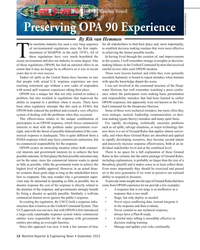 )
September 2023 - Maritime Reporter and Engineering News page: 12
)
September 2023 - Maritime Reporter and Engineering News page: 12. There have OPA90 responses, but apparently were not known to the Uni- been other regulatory attempts like this such as FEMA, but ? ed Command for the Deepwater Horizon. OPA90 both reduced the problem and created a very effective Some of those were technical mistakes, but more often they system of dealing
-
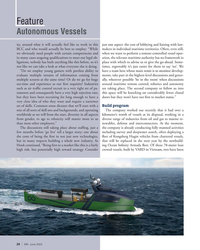 )
June 2023 - Marine News page: 24
)
June 2023 - Marine News page: 24? ng, just a the company is already conducting fully manned activities few months before ‘go live’ tell a larger story; one about including survey and deepwater search, often deploying a the costs of being the ? rst in not just new technologies, ? eet of Kongsberg Hugin vehicles from chartered vessels
-
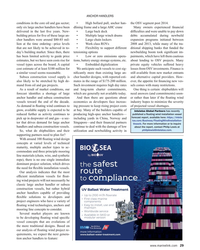 )
August 2023 - Maritime Reporter and Engineering News page: 29
)
August 2023 - Maritime Reporter and Engineering News page: 29vessel reduced further as activity continues to producing high-spec anchor handlers— forecast report, available here: https://intela- pick up in deepwater oil and gas—a sec- including yards in China, Norway and tus.com/Business/FloatingWindInstallation- tor that drives demand for large anchor Singapore—and
-
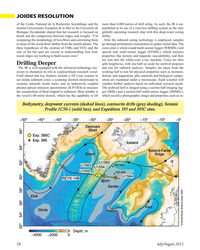 )
July 2023 - Marine Technology Reporter page: 28
)
July 2023 - Marine Technology Reporter page: 28(SHMSL), the vessel’s 60-meter derrick, which has the capability to lift which record a photographic image and properties such as re- Bathymetry, deepwater currents (dashed lines), contourite drifts (gray shading), Seismic Pro? le JC50-1 (solid line), and Expedition 395 and 395C sites. © Parnell-Turner
-
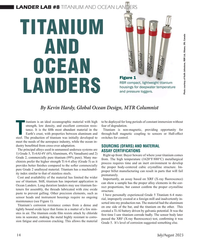 )
July 2023 - Marine Technology Reporter page: 14
)
July 2023 - Marine Technology Reporter page: 14LANDER LAB #8 TITANIUM AND OCEAN LANDERS TITANIUM AND OCEAN Figure 1 RBR compact, lightweight titanium housings for deepwater temperature and pressure loggers. LANDERS Photo courtesy of Keith Johnstone, RBR Ltd, Ottawa, ON, Canada By Kevin Hardy, Global Ocean Design, MTR Columnist itanium is an ideal
-
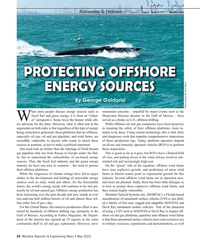 )
May 2023 - Maritime Reporter and Engineering News page: 24
)
May 2023 - Maritime Reporter and Engineering News page: 24people discuss energy sources such as ronmental concerns – impelled by major events such as the fossil fuel and green energy, it is from an “either- Deepwater Horizon disaster in the Gulf of Mexico – have Wor” perspective. Some favor the former while oth- served as a brake on U.S. offshore drilling. ers
-
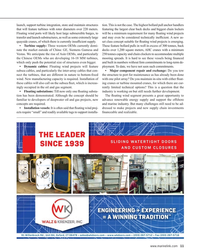 )
April 2023 - Maritime Reporter and Engineering News page: 11
)
April 2023 - Maritime Reporter and Engineering News page: 11. tion has been demonstrated. Although the concept should be The ? oating wind segment presents a great opportunity to familiar to developers of deepwater oil and gas projects, new advance renewable energy supply and support the offshore concepts are required. and marine industry. But many challenges
-
 )
April 2023 - Marine News page: 21
)
April 2023 - Marine News page: 21steps needed to avoid and mini- tions headlined “Floating Wind: Transfer Learnings of mize navigation con? icts. This is critical not just for safety Deepwater Development.” This category included a ses- but, Wise added, because it impacts the layout of the proj- sion on environmental and regulatory issues
-
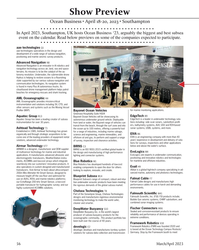 )
March 2023 - Marine Technology Reporter page: 56
)
March 2023 - Marine Technology Reporter page: 56, CHIRP sub-bottom, and monitoring technology to make the world safer, combined sonar imaging systems. cleaner and smarter. Fischer Connectors W66 DeepWater Buoyancy S10 Sealed and corrosion-resistant products to ensure DeepWater Buoyancy Inc. is the world’s largest reliability and performance of devices
-
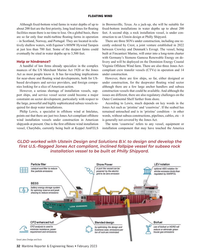 )
February 2023 - Maritime Reporter and Engineering News page: 32
)
February 2023 - Maritime Reporter and Engineering News page: 32for US- However, there are few ships, so far, either designed or based developers and service providers, and foreign compa- under construction, for the deepwater ? oating wind sector nies looking for a slice of American action. although there are a few large anchor handlers and subsea However, a serious
-
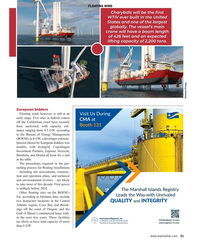 )
February 2023 - Maritime Reporter and Engineering News page: 31
)
February 2023 - Maritime Reporter and Engineering News page: 31take most of this decade. First power is unlikely before 2032. Other ? oating sites on the BOEM’s list, according to Intelatus data, include two deepwater locations in the Central Atlantic region; Coos Bay and Brook- ings off the coast of Oregon; and the Gulf of Maine’s commercial lease with- in the
-
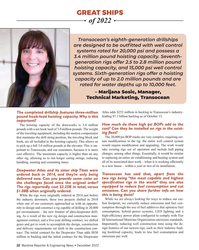 )
December 2022 - Maritime Reporter and Engineering News page: 32
)
December 2022 - Maritime Reporter and Engineering News page: 32duct work – when it is working ef? ciently handling, running and cementing times. in a new house – within a year or two of its installation. Deepwater Atlas and its sister ship Titan were ordered back in 2014, and they’re only being Transocean has said that, apart from the delivered now. Can
-
 )
December 2022 - Maritime Reporter and Engineering News page: 31
)
December 2022 - Maritime Reporter and Engineering News page: 31GREAT SHIPS of 2022 The Deepwater Atlas was launched this year in Singapore. What, speci? cally, is so special about it? The Deepwater Atlas is the ? rst of its kind eighth-generation drillship that will offer 20,000 psi well control capabilities and a 3.4 million pound hoisting capacity. The Deepwater
-
 )
December 2022 - Maritime Reporter and Engineering News page: 30
)
December 2022 - Maritime Reporter and Engineering News page: 30GREAT SHIPS of 2022 A Look inside the DEEPWATER ATLAS Marijana Sosic, Manager, Technical Marketing, Transocean discusses the “World’s First Eighth-Generation Ultra-Deepwater Drillship” 30 Maritime Reporter & Engineering News • December 2022 MR #12 (18-33).indd 30 12/4/2022 3:45:37 PM
-
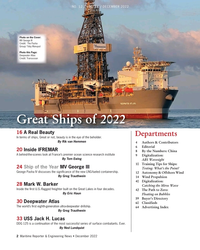 )
December 2022 - Maritime Reporter and Engineering News page: 2
)
December 2022 - Maritime Reporter and Engineering News page: 212 / VOL. 84 / DECEMBER 2022 Phot Pho P P P P Ph to on th the C Cover: : M MV George III C Credit: The Pasha G Group/ Toby Manuput P Photo this Page: D Deepwater Atlas C Credit: Transocean Great Ships of 2022 16 A Real Beauty Departments In terms of ships, Great or not, beauty is in the eye of the beholder
-
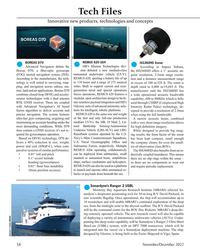 )
November 2022 - Marine Technology Reporter page: 58
)
November 2022 - Marine Technology Reporter page: 58unmanned ve- hicles or payloads from beneath the sea. Sonardyne’s Ranger 2 USBL Monterey Bay Aquarium Research Institute (MBARI) selected So- nardyne’s deepwater positioning tech for 50-m long R/V David Packard, its new scienti? c ? agship. Once operational, the ship will accommodate up to 18 researchers
